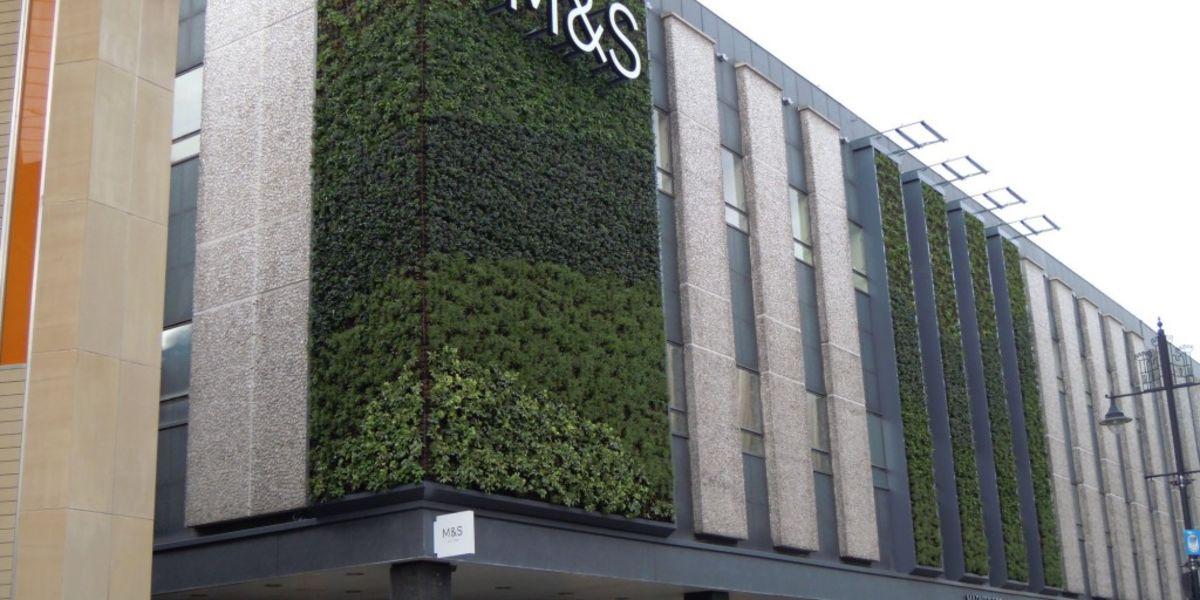Last updated: October 2021
Marks & Spencer transformed its Newcastle city centre store on Northumberland Street into one of the most eco-friendly in the north-east. (1) The striking development to the store includes various eco-features including the installation of a green living wall to improve the insulation of the building encourage biodiversity and improve customer experience (2, 3). The project also fits into Newcastle City Council's intention to transform Northumberland Street, and its surrounding area, into a European-leading retail destination (9)
Overview
Nature-based solution
- Nature on buildings (external)
- Green walls or facades
Key challenges
- Green space, habitats and biodiversity (SDG 15)
- Green space creation and/or management
- Economic development and employment (SDG 8)
- Economic development: service sectors
Focus
Creation of new green areas
Project objectives
1. Transformation Mark Spencers Northumberland Street store in Newcastle into one of the most eco-friendly and visually impressive one in the north east with the implementation of the following improvements:
- 167 square metres green wall
- a heat reclaim system that will improve energy efficiency and customer comfort
- intelligent door sensors and LED fridge lighting to improve M&S Newcastle's energy efficiency by 20% (1)
2. Achievement of Mark & Spencer's ‘Plan A’ 2020 energy efficiency targets
The objective of the green wall is to:
- Improve customer experience
- provide habitat for wildlife (1)
Implementation activities
The installation is made up of 16,000 individual plants including species such as sea pink, thyme, cranesbill, wood rush, hebe and ferns all naturally irrigated by rainwater (1)
Also, to celebrate the completion of the wall the retailer donated plants to a number of local primary schools to spread the environmental benefits across the city (1, 3)
Main beneficiaries
- Local government/Municipality
- Private sector/Corporate/Company
- Citizens or community groups
Governance
Management set-up
- Led by non-government actors
Type of initiating organisation
- Private sector/corporate actor/company
Participatory approaches/ community involvement
- Unknown
Details on the roles of the organisations involved in the project
Marks & Spencer announced plans to transform its Northumberland Street store (in Newcastle) into one of the most eco-friendly and visually impressive in the north east in 2015 (2). Based on the request, ANS (Global) designed and installed the green wall through the The ANS Living Wall System (6).
Project implemented in response to ...
... an EU policy or strategy?
Unknown
(M&S Plan A 2020 (which launched in 2007) started "whilst the health of the economy was waxed" and one of the goals of Plan A is to become the world's most sustainable major retailer. Plan A was integrated into the management process. (Ref. 7, 8) )
... a national policy or strategy?
Unknown
(See above. )
... a local policy or strategy?
Unknown
(See above. )
Financing
Total cost
More than €4,000,000
Source(s) of funding
- Corporate investment
Type of funding
- Other
Non-financial contribution
Unknown
Impacts and Monitoring
Environmental impacts
- Water management and blue areas
- Improved stormwater management
- Green space and habitat
- Promotion of naturalistic styles of landscape design for urban development
- Increased green space area
- Increased number of species present
- Enhanced support of pollination
Economic impacts
- Unknown
Socio-cultural impacts
- Cultural heritage and sense of place
- Increased appreciation for natural spaces
Type of reported impacts
Expected impacts
Presence of formal monitoring system
Unknown
Presence of indicators used in reporting
No evidence in public records
Presence of monitoring/ evaluation reports
No evidence in public records
Availability of a web-based monitoring tool
No evidence in public records
References
1. FridgeHub. (n.d.). M&S to give it's Toon Store a Green makeover. UK News. Website unavailable
2. Pressat Wire. (2015). Marks & Spencer Newcastle to Be Transformed Into Eco-Store. Accessed on October 25, 2020, Source link
3. NBS. (2015). Green wall success means Newcastle’s really growing places. Accessed on October 25, 2020, Source link
4. Acre. (2015). This isn't just a store, it's an M&S eco-store. Website not available
5. Canadian Groceries. (2016). Marks & Spencer makes green its Plan A. Canadian Grocer. Accessed on October 25, 2020, Source link
6. ANS Global. (n.d.). Supporting Marks and Spencer with a living wall installation. News. Accessed on October 26, 2020, Source link
7. Marks & Spencer. (n.d.). Plan A 2020. Blog. Marks & Spencer. Accessed on October 25, 2020, Website not available
8. Marks & Spencer. (n.d.). Delivering Plan A. Marks & Spencer. Accessed on October 25, 2020, Source link
9. Bdaily News. (2016). Partnership invites Newcastle businesses to be part of city centre growth plans. Accessed on October 25, 2020, Source link
10. Scotscape. (2011). Scotscape installs living wall and green roof for flagship M&S store. Website not available
11. Marks & Spencer. (2017). M&S launches Plan A 2025 - an ambitious costomer focused sustainability plan. Accessed on October 25, 2020, Source link
12. Marks & Spencer Property. (2015). Property biodiversity guide. Marks & Spencer. Accessed on October 25, 2020, Source link
13. Marks & Spencer. (2020). 2020 Plan A Report. Accessed on Octoner 25, 2020, Source link
2. Pressat Wire. (2015). Marks & Spencer Newcastle to Be Transformed Into Eco-Store. Accessed on October 25, 2020, Source link
3. NBS. (2015). Green wall success means Newcastle’s really growing places. Accessed on October 25, 2020, Source link
4. Acre. (2015). This isn't just a store, it's an M&S eco-store. Website not available
5. Canadian Groceries. (2016). Marks & Spencer makes green its Plan A. Canadian Grocer. Accessed on October 25, 2020, Source link
6. ANS Global. (n.d.). Supporting Marks and Spencer with a living wall installation. News. Accessed on October 26, 2020, Source link
7. Marks & Spencer. (n.d.). Plan A 2020. Blog. Marks & Spencer. Accessed on October 25, 2020, Website not available
8. Marks & Spencer. (n.d.). Delivering Plan A. Marks & Spencer. Accessed on October 25, 2020, Source link
9. Bdaily News. (2016). Partnership invites Newcastle businesses to be part of city centre growth plans. Accessed on October 25, 2020, Source link
10. Scotscape. (2011). Scotscape installs living wall and green roof for flagship M&S store. Website not available
11. Marks & Spencer. (2017). M&S launches Plan A 2025 - an ambitious costomer focused sustainability plan. Accessed on October 25, 2020, Source link
12. Marks & Spencer Property. (2015). Property biodiversity guide. Marks & Spencer. Accessed on October 25, 2020, Source link
13. Marks & Spencer. (2020). 2020 Plan A Report. Accessed on Octoner 25, 2020, Source link

